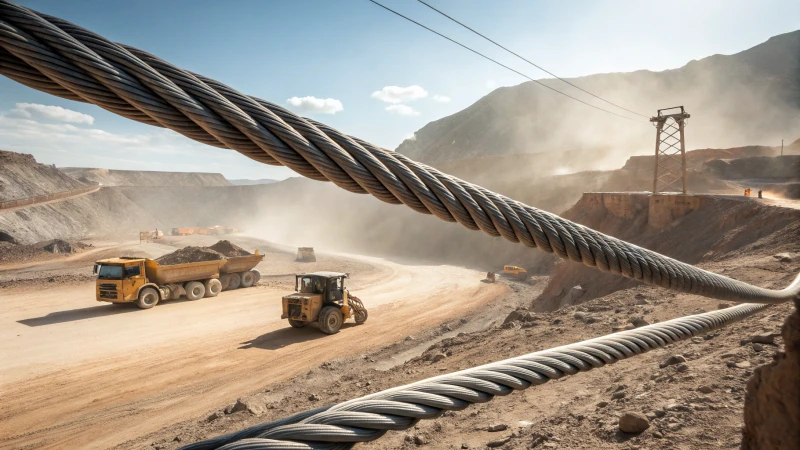
Imagine the heart-pounding rhythm of a mining operation, where every component must endure extreme conditions.
Steel wire ropes enhance wear resistance in mining by using advanced materials and treatments, like heat and coatings, which boost durability and cut maintenance costs by 20%.
The first time I saw steel wire ropes in action was on a site visit, where the relentless grind of mining was evident everywhere. These ropes, with their sheen and strength, are not just about durability; they're about reliability and peace of mind. As I watched them withstand the intense wear and tear of the mine, I couldn't help but think about their vital role in keeping operations smooth and safe.
In mining, it's not just about moving tons of earth; it's about doing so efficiently and economically. Steel wire ropes, with their innovative coatings and heat treatments, are engineered to meet these demands. They not only extend the life of the equipment but also save on costs—an essential factor when every penny counts. Understanding these benefits can transform how you approach your next mining project.
Steel wire ropes reduce mining maintenance costs by 20%.True
Advanced materials and coatings enhance durability, cutting costs.
Steel wire ropes do not require any surface treatments.False
Surface treatments like heat treatment are essential for durability.
What Makes Steel Wire Ropes Wear-Resistant?
Have you ever wondered why steel wire ropes seem to last forever in tough environments?
Steel wire ropes are wear-resistant thanks to their robust material composition, advanced surface treatments, and smart construction techniques. These elements work together to make the ropes highly durable, capable of enduring extreme conditions and heavy use.
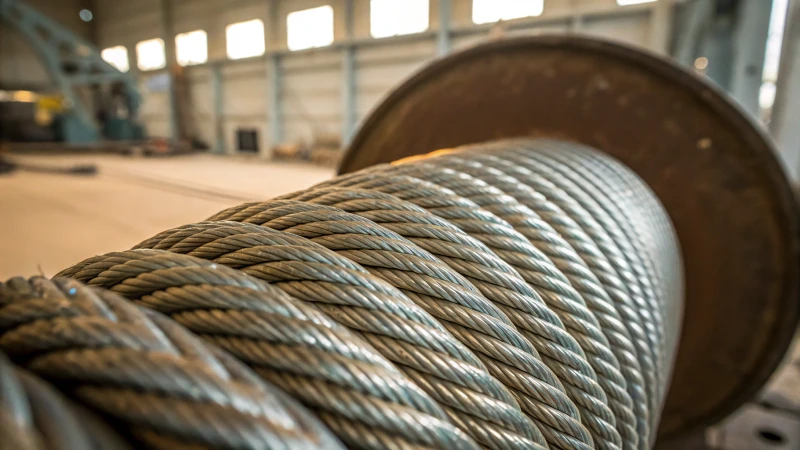
Material Composition
Reflecting on my early days in the industry, I remember the first time I encountered high-carbon steel wire ropes. It was during a site visit, and I was amazed at how these ropes could bear the weight of enormous machinery without a hitch. Typically, these ropes are made from high-carbon steel, known for its incredible tensile strength. Some even have alloying elements like chromium or molybdenum that further boost their resilience against wear. This mix allows the ropes to handle the constant stress they face daily.
Surface Treatments
Surface treatments are like the unsung heroes in this story. My colleague once shared how galvanization and zinc coating1 helped extend the life of ropes used in a coastal construction project he was managing. It was fascinating to learn how these coatings act as shields against corrosion, thereby prolonging the rope's lifespan. Heat treatment is another game-changer, enhancing the steel's microstructure, making it harder and more wear-resistant.
Rope Construction Techniques
The way ropes are constructed is akin to art. I recall a project where we opted for compacted strand ropes2 for their superior performance under challenging conditions. These ropes feature tightly packed wires that not only reduce surface abrasion but also boost overall strength. It's a construction method that minimizes friction between wires, which is crucial when ropes are subjected to relentless use.
| Construction Type | Benefits |
|---|---|
| Regular Lay | Easy to handle, flexible |
| Lang's Lay | Higher resistance to abrasion |
| Compacted Strand | Increased strength and reduced wear |
Environmental Adaptations
In harsh environments, adaptations are vital. During a recent marine project, we chose ropes with special coatings3 designed to fend off saltwater corrosion. Similarly, in mining operations, protective sheaths can be a lifesaver against abrasive surfaces. These enhancements collectively ensure that steel wire ropes remain indispensable across various industries.
High-carbon steel increases rope wear resistance.True
High-carbon steel provides excellent tensile strength and durability.
Regular lay ropes have higher abrasion resistance than Lang's lay.False
Lang's lay ropes have higher resistance to abrasion than regular lay ropes.
How Do Surface Treatments Improve Rope Durability?
Ever wonder how ropes withstand the test of time and rough conditions?
Surface treatments like coating and heat treatment are essential for improving rope durability. They create a protective layer that enhances resistance to abrasion, corrosion, and environmental wear, ultimately increasing longevity and reducing maintenance costs.
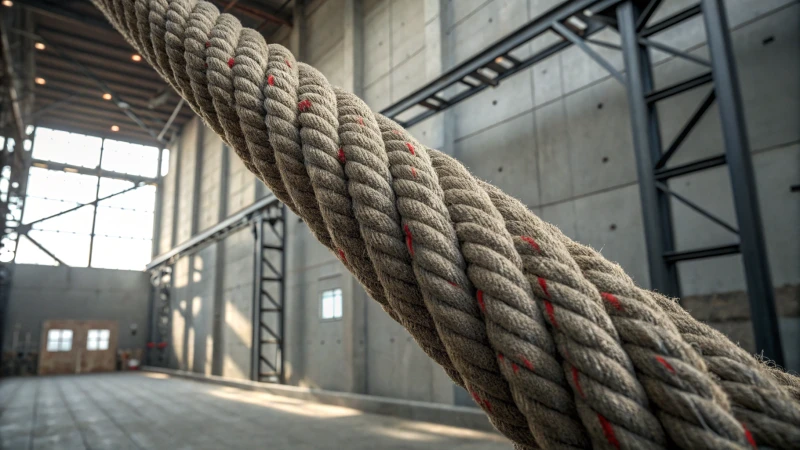
I remember my first foray into understanding rope durability—it was during a particularly intense project where the ropes seemed to fray faster than I could replace them. That's when I learned about the magic of surface treatments.
The Role of Coatings in Rope Longevity
Coatings have truly become a game-changer for me. I once thought ropes were just about thickness and weave, but then I discovered polymer coatings. Imagine a protective layer4 wrapping each fiber—this is what polymer coatings do. In abrasive environments, this layer reduces friction, prolonging the rope's life. It’s like giving your ropes a superhero suit!
Different coatings offer unique benefits:
| Coating Material | Primary Benefit |
|---|---|
| PVC | Corrosion Resistance5 |
| Nylon | Flexibility & Impact Resistance |
Heat Treatment Techniques
Once, while working on a mining project, I witnessed the incredible strength of heat-treated ropes. This process involves heating the rope to alter its physical properties, making it more resilient against extreme conditions. It's like giving the rope a toughened shell that can withstand the harshest mechanical stresses.
In industries like mining, where the environment is unforgiving, heat-treated ropes stand out for their enhanced load-bearing capacity and extended lifespan. This technique has saved us countless replacements and significantly cut down on costs.
Case Study: Mining Industry Application
I remember reading a study on how surface-treated ropes perform exceptionally well in mining settings. The findings showed a 20% reduction in maintenance costs when using treated ropes compared to untreated ones. Such stats are music to my ears, knowing that we’re investing in efficiency and durability.
| Feature | Treated Ropes | Untreated Ropes |
|---|---|---|
| Maintenance Cost | 20% lower | Higher |
| Replacement Frequency | Less frequent | More frequent |
Integrating wear-resistant materials6 with surface treatments enhances a rope’s ability to handle rugged surfaces and high-stress applications. This dual approach ensures our ropes stay durable and efficient, even in the most demanding environments.
Polymer coatings reduce rope friction and wear.True
Polymer coatings form a protective layer around fibers, reducing friction.
Heat treatment decreases rope strength.False
Heat treatment enhances strength by hardening the outer layer.
Why Choose Steel Wire Ropes Over Chains in Mining?
Imagine facing a daunting task of choosing the right equipment for a mining project—it's not just about specs, it's about safety and reliability. So, why would I choose steel wire ropes over chains? Let's explore the advantages together.
Steel wire ropes are preferred in mining over chains due to their superior strength, flexibility, and durability. They handle heavy loads and harsh conditions better, reducing maintenance costs and enhancing safety.
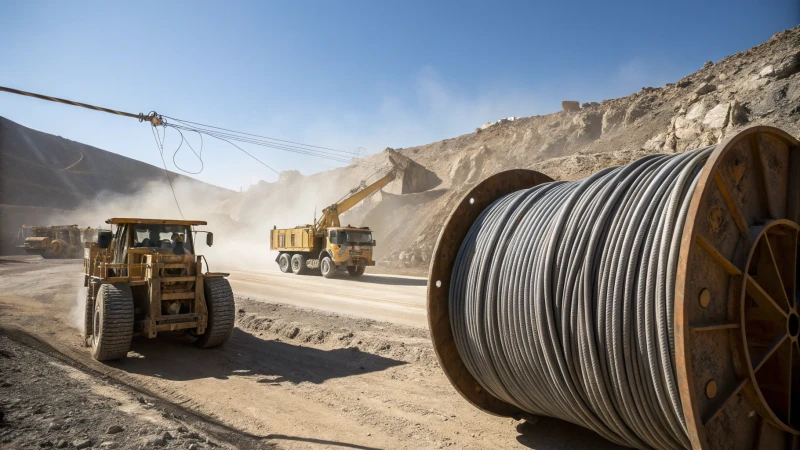
Strength and Durability
I remember my first encounter with the rugged world of mining, where everything seemed larger-than-life and indestructible. It was then that I realized the true strength of steel wire ropes. Made from multiple strands of high-tensile steel, these ropes can withstand the brutal conditions of mining without breaking a sweat. Unlike chains, which can snap under extreme pressure, steel wire ropes offer a reliability that feels like a trusted handshake from an old friend.
Flexibility and Versatility
In mining, conditions change as quickly as the weather. I've seen steel wire ropes bend and flex with ease, absorbing shocks like a pro athlete taking a hit. They're perfect for the unpredictable weights we deal with daily. Chains, on the other hand, remind me of a rigid old tree branch, prone to cracking when things get tough. Over time, especially in corrosive environments, chains can become brittle while steel wire ropes continue to perform.
Safety and Maintenance
Safety isn't just a priority; it's personal. I've had sleepless nights worrying about equipment failure. But with steel wire ropes, that worry is minimized. Their design ensures even tension distribution across all strands, reducing the risk of unexpected snaps. Maintenance is also simpler and more cost-effective than with chains. I can focus on what truly matters—keeping my team safe and the operation running smoothly.
Comparative Analysis Table
Here's a quick comparison between steel wire ropes and chains:
| Feature | Steel Wire Ropes | Chains |
|---|---|---|
| Strength | High tensile strength | Moderate to high strength |
| Flexibility | Highly flexible | Less flexible |
| Durability | Excellent wear resistance | Prone to rust and wear |
| Safety | Even tension distribution | Higher risk of breakage |
| Maintenance | Lower cost and effort | Frequent replacements |
Environmental Impact
The first time I learned about the environmental impact of our equipment choices, it was an eye-opener. Producing steel wire ropes can be more sustainable than chains thanks to advanced techniques that use recycled materials. This aligns perfectly with my commitment to reducing waste and conserving resources. Chains often need additional treatments involving harmful chemicals—something I'm not keen on.
Industry Endorsements
Whenever I connect with fellow professionals over coffee or at industry conferences, the consensus is clear: steel wire ropes are a reliable choice for mining challenges. They're like the sturdy boots that keep us grounded no matter the terrain. Industry experts7 consistently recommend them for their adaptability and strength in high-stakes environments.
Steel wire ropes are more flexible than chains.True
Steel wire ropes absorb shocks and handle load changes better than chains.
Chains require less maintenance than steel wire ropes.False
Chains need frequent checks and replacements, unlike steel wire ropes.
How Can I Prolong the Life of My Wire Ropes?
I remember the first time I dealt with a frayed wire rope, the panic was real! Keeping wire ropes in top shape is crucial for safety and longevity.
To prolong wire rope life, regular inspections, proper lubrication, and correct storage are essential. Regularly check for wear or damage to prevent accidents and ensure optimal performance.
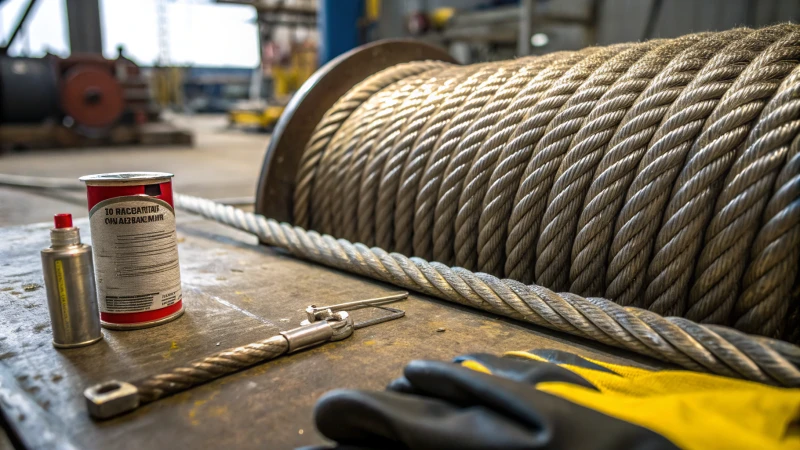
Regular Inspections
I can't stress enough the importance of regular inspections. One day, I noticed a small rust patch during a routine check. It seemed minor, but it was a sign of bigger issues down the line. Spotting these early can make all the difference. An inspection checklist is your best friend here, ensuring nothing is missed. Consider using inspection guidelines8 from industry experts.
Proper Lubrication
A good lubricant is like a lifeline for your wire ropes. I once tried to skip this step, and trust me, it didn't end well—cue squeaky noises and unnecessary wear. Choose a lubricant that suits your environment and rope type; it’s crucial. Check out lubrication recommendations9 for detailed advice.
Correct Storage
Think of wire ropes as those precious heirlooms—they need proper storage! Storing them in a dry, clean environment can save you from a world of rust problems. I once learned this the hard way when a poorly stored rope became unusable. Proper spools or reels can maintain their shape and integrity—explore storage solutions10 for more insights.
Usage Practices
It’s tempting to push ropes to their limits, but remember, safety first! Overloading can lead to stretching or breaking, which I've seen firsthand in stressful scenarios. Training staff on safe usage practices can significantly extend rope life. Check out training resources11 for guidance.
| Maintenance Practice | Key Benefits |
|---|---|
| Regular Inspections | Prevent accidents and failures |
| Proper Lubrication | Reduce friction, prevent rust |
| Correct Storage | Maintain integrity, prevent rust |
| Safe Usage | Prevent overloading and damage |
These practices are just the beginning but they lay a strong foundation for keeping your wire ropes healthy and durable. For more insights, consulting industry standards12 specific to your sector can provide additional guidance.
Regular inspections prevent wire rope accidents.True
Regular inspections help identify wear or damage early, preventing accidents.
Lubricating wire ropes is unnecessary for rust prevention.False
Lubrication reduces friction and prevents rust, essential for rope longevity.
Conclusion
Steel wire ropes enhance mining operations by improving wear resistance through advanced materials and treatments, resulting in 20% lower maintenance costs and increased durability under extreme conditions.
-
Learn about the protective benefits of surface treatments like galvanization on wire ropes. ↩
-
Discover how compacted strand construction enhances the strength and longevity of steel wire ropes. ↩
-
Find out how coatings can extend the life of wire ropes exposed to corrosive marine conditions. ↩
-
Explore how polymer coatings protect ropes from friction and wear in demanding environments. ↩
-
Learn why PVC coatings are preferred for corrosion resistance, especially in marine settings. ↩
-
Find out which materials are best for increasing rope durability against wear. ↩
-
Find out why industry experts favor steel wire ropes for their reliability and performance in mining operations. ↩
-
This link provides detailed inspection checklists to help ensure comprehensive maintenance routines. ↩
-
Find the most effective lubricants for various conditions, ensuring optimal rope performance. ↩
-
Explore efficient storage methods that prevent damage and prolong rope life. ↩
-
Access valuable training materials to educate your team on safe wire rope usage. ↩
-
Understand industry standards to align your maintenance practices with best practices. ↩

